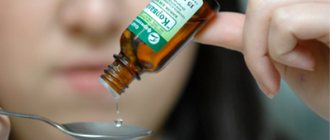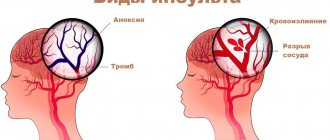Corvalol
- a combination drug consisting of several active ingredients. The composition of Corvalol is as follows (starting with the strongest component and ending with the weakest):
- Ethyl alcohol 95%
. According to many doctors, this is almost the main active ingredient of Corvalol. Ethyl alcohol (aka alcohol) has a sedative (calming, inhibitory) effect on the nervous system, and through it on the entire body. Its second effect is an analgesic, and this effect applies to all types of pain. In large doses it can cause a state of anesthesia with complete loss of consciousness and pain sensitivity. It is a psychoactive substance that can change and darken consciousness and cause mental and physical dependence. - Phenobarbital
. Sleeping substance. Just like alcohol, it has an inhibitory effect on the central nervous system, causing a decrease in pain sensitivity. The second most powerful active ingredient (after ethyl alcohol) is Corvalol. Just like ethyl alcohol, it is a psychoactive substance and can cause addiction. When combined with alcohol, phenobarbital produces a strong sedative effect that affects all psychosomatic symptoms. - Peppermint leaf oil
. The main component is menthol, which provides a slight analgesic and calming effect. - Ethyl bromoisovalerianate
(ethyl ester of alpha-bromoisovaleric acid). It is the active ingredient of the essential oil of a plant such as Valerian officinalis (or “Cat grass”). This perennial herb has been known for its calming effects since antiquity.
Available in bottles of 15 and 25 milliliters. The recommended dose of Corvalol is 15-30 drops orally at a time, up to 2 or 3 times a day.
Medicines similar to Corvalol are common in our country: valocordin, valoserdin, corvaldin.
Indications for use
The medication in solid form is prescribed for the following symptoms:
- increased irritability;
- vegetative-vascular dystonia;
- hypertensive diseases;
- disturbed sleep;
- spasms of the coronary vessels.
Drops are effective for conditions such as:
- central nervous system disorder;
- neurotic state;
- mildly disturbed heartbeat;
- disturbed sleep.
Combination with other medications
When Corvalol is combined with drugs from the group of sedatives, hypnotics, and antiallergic drugs, an increased suppressive effect on the nervous system is observed.
Phenobarbital, which is included in the structure of the drug, can reduce the effectiveness of coumarin, as well as glucocorticoids, medications from the group of oral contraceptives - the doctor should inform patients about this.
Under the influence of substances included in the structure of the drug, the effect of local anesthetics and painkillers for oral use may increase. Corvalol increases the toxicity of Methotrexate when used simultaneously.
Instructions for use
Pills
The medication is placed under the tongue when a quick effect is needed, or orally.
Corvalol can be taken 2 times a day, no more than 2-3 tablets.
The permissible single dose is 1 tablet; in case of urgent need, the dose can be increased to 3 tablets.
Drops
Dilute 15-25 drops of Corvalol in 50 ml of liquid. For tachycardia, the permissible single dose can be no more than 50 drops.
Depending on the age category and clinical situation, children are prescribed from 5 to 15 drops per day.
The length of treatment will depend on the indications. Sometimes a one-time use is enough. In some situations, drops/tablets should be taken 3 times a day. The duration of therapy is determined by the doctor, taking into account the therapeutic characteristics of the drug and its tolerability.
Restrictions
Before using the medicine, a person should carefully read the instructions, since Corvalol has contraindications. These include:
- Increased sensitivity to drug substances.
- Breast-feeding.
- Severe disturbances in liver function.
- Age up to twelve years.
- Kidney failure.
The drug can be used with caution during pregnancy and bradycardia. How many drops of Corvalol do you need to calm down?
Contraindications
For two types of medicinal drugs:
- acute renal and liver failure;
- lactation period;
- epilepsy;
- excessive sensitivity to the drug.
Tablets are also contraindicated in the following cases:
- lactose indigestibility;
- acute form of chronic heart failure;
- lack of glucose-galactose malabsorption;
- susceptibility to bromine;
- pregnancy.
Symptoms of sleep disorders
Many people are mistaken in believing that sleep disorders are necessarily associated with its complete absence or inability to fall asleep without sleeping pills or sedatives. Insomnia has many more manifestations, and it can develop so imperceptibly and gradually that a person sometimes does not even connect the state of chronic fatigue, apathy, and decreased tone with how and how much he sleeps. Therefore, it is important to pay attention to the following symptoms that indicate sleep problems.
- Difficulty falling asleep. It can take more than an hour from the moment you get into bed until you fall asleep. This time is not reduced even if you are physically tired.
- The desire to sleep disappears after you go to bed, although it was clearly felt before.
- During sleep, you hear everything happening around you.
- When you try to sleep, you begin to be disturbed by heat, cold, an uncomfortable bed, any sensations in your body - any factors that did not bother you before.
- Even if sleep comes quickly, after a short period of time you wake up and can no longer fall asleep.
- In the morning there is no feeling of freshness and vigor, and during the day you are haunted by drowsiness and lack of energy.
- Superficial sleep, with frequent and causeless awakenings (not related to the desire to drink, go to the toilet, wrap yourself more tightly in a blanket, etc.).
These are the main symptoms of insomnia, which can be supplemented by others (for example, irritability, mood swings, lack of appetite or, conversely, bouts of insatiable hunger, etc.).
Adverse reactions
Corvalol in tablets and drops can cause negative effects:
- dizziness;
- excessive sleepiness;
- loss of performance;
- rash, itching;
- gastrointestinal disorder;
- labored breathing.
With prolonged use of the drug, there is a possibility of accumulation of bromine in the body, disruption of osteogenesis, development of symptoms of bromism, such as rhinitis, acne, conjunctivitis, lacrimation, stress, depression of the central nervous system.
Negative consequences, as a rule, disappear without a trace after reducing the dose or completely stopping the drug.
Compound
The effects of taking Corvalol are easily explained by its composition.
Alpha-bromoisovaleric acid ethyl ester has a sedative effect similar to valerian. It helps relax the smooth muscles of internal organs, slows down the transmission of nerve impulses and reduces blood pressure.
Phenobarbital in small dosages causes drowsiness, relaxation, and also relaxes smooth muscles. Increases the resistance of the nervous system to irritants, promotes the onset of sleep, but the sleep that occurs is not physiological.
Peppermint leaf oil promotes dilatation of blood vessels in the heart and brain. Strengthens intestinal contractility.
The combination of these components enhances their effect.
Overdose
Overdose symptoms:
- low blood pressure;
- excessive excitability;
- lethargy;
- unclear consciousness.
In case of a severe overdose of the substance, rapid heartbeat, arrhythmia, respiratory problems, and in rare cases, coma or severe outcome may be observed.
In case of side effects, you should stop taking Corvalol, rinse your stomach, eliminate caffeine from your daily diet, and give up nicotine.
Causes of sleep disorders
When treating chronic insomnia or other forms of sleep disorders with various medications, it is important to determine the reason why the disorder developed. Among the most common factors identified in people who consult a doctor with complaints of insomnia are the following.
Stress. Tense relationships in a team, the need to withstand the “career race”, a high level of professional or personal responsibility and much more can cause chronic stress and, as a result, the development of insomnia. In addition, this condition in adults can be caused by other circumstances: family quarrels, divorce, litigation, financial difficulties, change of place of residence, loss of property, health problems, etc.
Non-compliance with the daily routine. Maintaining natural biorhythms is important for quality sleep. Sleep is a state that begins gradually with the slowing down of some processes in the body and the activation of others. So, when darkness sets in (that is, in the absence of light stimuli), changes occur in the human body that serve as a signal for the transition to sleep. If you ignore biorhythms (working night shifts, the habit of sitting at the computer at night, etc.), these mechanisms are disrupted and sleep problems may gradually develop. Moreover, even returning to normal mode does not always produce the expected effect. The time it takes to fall asleep can be several hours.
Taking certain medications. Insomnia is often caused by the use of the following medications: antihypertensive drugs (alpha and beta blockers), decongestants, antiepileptics, respiratory drugs (theophylline), hormones, etc.
Bad habits. This category includes all factors that in one way or another negatively affect the functioning of internal organs and the psyche. Taking substances that have a stimulating or depressing effect (nicotine, alcohol, caffeine, etc.), the habit of having a large dinner before bed, a sedentary lifestyle of adults and other factors can desynchronize the mechanisms responsible for sleep and its quality.
Some diseases. Insomnia is often caused by symptoms of some disease. These may be breathing problems due to ARVI, joint pain due to arthritis, headache due to hypertension, etc. Such symptoms can acquire the properties of distractions that interfere with sleep, and the underlying disease that causes such symptoms can sometimes negatively affect biochemical processes, responsible for sleep.
Negative environmental factors. The conditions in which you fall asleep are very important for the quality of your sleep. Therefore, with frequent or constant exposure to irritants in the form of bright light, increased noise levels, an uncomfortable bed, etc., falling asleep becomes increasingly difficult for an adult, and chronic insomnia may develop over time.
special instructions
The presence of phenobarbital in the drug sometimes contributes to the development of syndromes such as Steven-Johnson or Leilla, which is especially important at the initial stage of taking the drug. Ethanol and phenobarbitol are the main components of the drops, their turnover is 55%. The alcohol concentration in small doses is 250 mg, which corresponds to 6.5 ml of beer. While taking the drug, the following are possible:
- dizziness;
- lethargy;
- drowsiness;
- violation of coordination of actions.
During the period of treatment with the drug:
- It is prohibited to drink alcohol;
- It is not recommended to engage in potentially dangerous activities, including driving.
You can buy the drug at any pharmacy. Tablets and drops in containers of 15 and 25 ml are available without a prescription. Vials containing 50 ml of the substance are sold with a prescription.
The shelf life of drops is 2.5 years, tablets - 24 months from the date of production.
The medication should be stored at room temperature.
"Valoserdin" or "Corvalol"
The second medication, as previously mentioned, has several generics that have a similar composition and have the same effect. As a rule, there is no difference which drug to choose - Corvalol or Valoserdin.
Since both remedies are characterized by the same therapeutic effects, it does not matter which of them is best used to eliminate insomnia. The differences in the composition of these medications are not very significant. The difference is that Valoserdin contains a little hop oil, which has a sedative and antispasmodic effect.
According to medical experts, in order to reduce high blood pressure, as well as calm down, eliminate the feeling of fear, and fall asleep faster, it is enough to drink 15-20 drops of the medicine, diluting them in a small amount of water. It must be remembered that if you use both remedies over a long period of time, addiction may occur. For this reason, they should not be abused.
The active ingredients of Valoserdin are exactly the same as those of Corvalol. But in addition, the structure contains oregano oil, with its help the medicine has a wider area of use. "Valoserdin" helps improve sleep and helps eliminate problems with falling asleep that are associated with emotional stress.
When combined with other sedatives, it may cause side effects. The differences between Valoserdin and Corvalol are only in the auxiliary components that are included in the composition.
Both drugs have the same effect on the patient's body. The price of Corvalol is a little less, for this reason it is more in demand. This drug can be used to treat children over twelve years of age. If we consider Valoserdin, then its use is allowed only for patients over eighteen years of age. Both drugs can provoke dependence, which must be taken into account by people planning long-term treatment.
Drug during pregnancy
The instructions indicate that Corvalol tablets and drops are contraindicated for use while pregnant.
The use of the drug in the 1st trimester of pregnancy can negatively affect the development of the fetus, and in the 3rd semester it can provoke a disorder of the respiratory system of the newborn.
If there is an urgent need to take the drug during pregnancy, Corvalol can be used in minimal quantities. However, if possible, it is advisable to stop taking the drug.
Other Adverse Effects
Self-medication when refusing examination and qualified medical care can lead to delayed diagnosis of serious diseases, worsening the prognosis and increasing the likelihood of developing serious complications: hypertensive crises, strokes, heart attacks.
Some patients, even with a diagnosis and prescribed treatment, continue to prefer Corvalol, as a well-known and fast-acting remedy. However, unlike antiplatelet agents, antihypertensive drugs or statins, the drug does not affect the mechanisms of development of disorders in any way - it only masks existing symptoms.
Don't forget about habit and the placebo effect. With constant use, the next dose in itself becomes a calming ritual and looks like taking care of your health. The apparent effectiveness of treatment may be due to psychological factors, and not at all to the effect of the drug. It turns out that a person is in vain poisoning his body with barbiturates, but does not receive the necessary treatment.
Benefits and harms
Everyone knows for what purpose the drug is taken. The effectiveness of Corvalol has been proven by many years of practice. However, recently information has begun to appear that the substance not only heals, but also causes harm to health.
Since the drug contains an antispasmodic - ethyl bromizovalerant, which, taking into account the dosage, can have a hypnotic or sedative effect on the body.
Phenobarbital, which is included in the composition, does not have a hypnotic effect, however, when taking the usual dose, it dilates blood vessels.
Peppermint oil can provoke a spasmodic reaction and dilate blood vessels. With an increased dose, it causes constipation and disrupts the functioning of the gastrointestinal tract.
With long-term use of the drug in large doses, phenoborbital leads to an unsteady gait, speech impairment, memory loss, and causes neurological disorders.
Development of addiction
Uncontrolled use of the drug leads to addiction, not only psychological, but also physical. The person becomes distracted and suffers from deterioration of memory and attention. Movement disorders are possible, especially in old age.
If you stop taking it abruptly, withdrawal syndrome develops. A person is worried about increasing weakness, constant anxiety, nausea, vomiting, dizziness, and tremors of the limbs. Fainting is possible. In severe cases, seizures occur, and some patients experience delirium.
Tests for barbiturates
In 2006, the Ministry of Health of the Russian Federation issued a decree that all testing of people for drug or psychoactive substance abuse must be carried out in 2 stages. The first stage is preliminary, the second is confirmatory.
The preliminary stage is not legally binding, but it helps confirm suspicions that a person is a drug abuser. For preliminary diagnosis of the presence of barbiturates in the blood, rapid tests can be used. They work using the method of thin layer chromatography or enzyme immunoassay.
To study the presence of barbituric acid metabolites in the body, urine or saliva is most often used. Express tests cost from 40 to 500 rubles. There are specific tests for barbiturates only, and there are also test tablets that can be used to immediately determine the presence of metabolites of other drugs.
Test tablets for 5-10 types of drugs are more effective in diagnosis. This is due to the fact that barbiturate drug addicts usually combine the use of 2-3 types of drugs. Knowledge about the types of drugs that the patient uses is important, since treatment for combined addictions is different.
The following methods are used for confirmatory testing:
- gas-liquid chromatography;
- gas chromatography-mass spectrometry;
- three-layer chromatography.
These methods have legal force. That is, if using any of these methods they detect drugs in the body, this analysis can be used in legal proceedings. This is important because rapid tests can give incorrect results: it is easier to deceive them by replacing urine or saliva.
In order to correctly perform the analysis, you need to know what the elimination period of drugs based on barbituric acid is.
Get help now
Do any of your relatives or friends have an addiction? Have you tried in every possible way to help, but as a result the person still returned to his past life?
You are not the first to encounter this problem, and we can help you.
We guarantee anonymity, we will persuade you to undergo treatment, and we will help you choose a center.
Call us
+7
or
Call me
Detoxification in hospital
Inpatient detoxification from barbiturates always begins with gastric lavage and a cleansing enema. If the patient's condition does not allow these manipulations, infusion therapy is prescribed to reduce blood acidity. It is believed that phenobarbitals are eliminated faster in an alkaline environment.
The second stage of detoxification in a hospital is the appointment of forced diuresis. This is possible with copious infusions and the administration of loop diuretics. An example of such drugs is furosemide. Such diuretics should not be used for more than 1-2 days. They wash out a lot of minerals from the blood plasma, and this can cause cardiac arrest.
In case of severe intoxication, hemodialysis or hemosorption is prescribed. If necessary, artificial ventilation can be performed.










